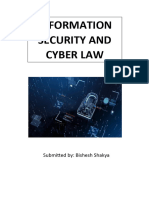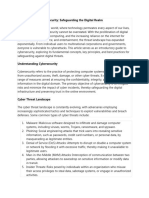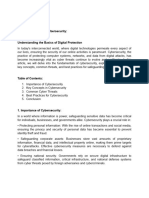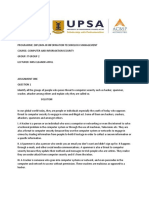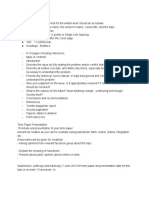Comprehensive Cybersecurity Guide
An in-depth guide covering cybersecurity threats, best practices, network security,
business protection, AI security, cyber laws, and future trends.
This guide provides a comprehensive overview of cybersecurity, covering at least 15 detailed
aspects for each key topic.
Index
1. Introduction to Cybersecurity
2. Types of Cyber Threats
3. Best Practices for Cybersecurity
4. Network Security & Encryption
5. Cybersecurity for Businesses
6. Cloud Security
7. Internet of Things (IoT) Security
8. Artificial Intelligence and Cybersecurity
9. Ethical Hacking & Penetration Testing
10. Cyber Laws & Regulations
11. Incident Response & Disaster Recovery
12. Future of Cybersecurity
Introduction to Cybersecurity
- Cybersecurity protects digital information from unauthorized access.
- Ensures confidentiality, integrity, and availability of data.
- Prevents identity theft, financial loss, and data breaches.
- Addresses cybercrime growth due to increased digital dependence.
- Covers multiple security layers, including endpoint and network security.
- Governments enforce cybersecurity laws and regulations.
- Businesses implement cybersecurity to prevent financial damage.
- Personal cybersecurity includes strong passwords and secure browsing.
- Cybersecurity professionals include ethical hackers and analysts.
- AI and automation play a significant role in modern cybersecurity.
- Cyber awareness campaigns educate users on safe online practices.
- Attack vectors include phishing, malware, and social engineering.
- Security evolves from basic antivirus to advanced threat detection.
- Insider threats pose risks to organizations.
- Global collaboration is essential for combating cyber threats.
Types of Cyber Threats
- Malware infects systems and steals data.
- Phishing deceives users into revealing sensitive information.
- Ransomware encrypts files and demands payment.
- Social engineering manipulates users into compromising security.
- Denial-of-Service (DoS) attacks overwhelm networks.
- Advanced Persistent Threats (APTs) involve long-term hacking efforts.
- Zero-day exploits target undiscovered software vulnerabilities.
- Trojans disguise malicious software as legitimate programs.
- Keyloggers record keystrokes to capture credentials.
- Botnets use infected devices for large-scale attacks.
- SQL injection compromises databases.
- Cross-Site Scripting (XSS) injects malicious scripts into websites.
- Insider threats occur when employees misuse access privileges.
- IoT vulnerabilities allow hackers to exploit connected devices.
- Man-in-the-Middle attacks intercept communication.
Best Practices for Cybersecurity
- Use strong, unique passwords.
- Enable Multi-Factor Authentication (MFA).
- Keep software and systems updated.
- Install and maintain firewalls.
- Use antivirus and anti-malware software.
- Encrypt sensitive data.
- Backup data regularly.
- Educate employees about phishing and cyber risks.
- Restrict access based on job roles.
- Monitor network traffic for suspicious activities.
- Disable unused services and applications.
- Secure Wi-Fi networks and use VPNs.
- Protect physical devices from theft or tampering.
- Establish an incident response plan.
- Stay informed about new cybersecurity threats.


















